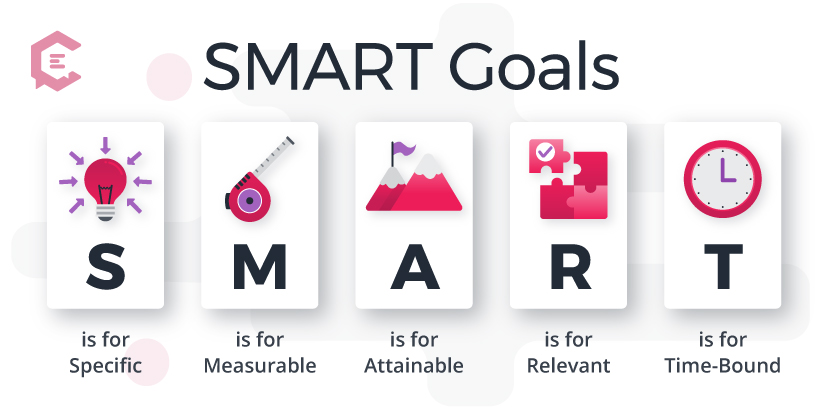SMART goals are Specific, Measurable, Attainable, Relevant, and Time-bound. Using the SMART goal method is an effective way to outline your own aspirations while challenging you to think critically about why you’re making a goal, how you’ll do it, and when you’ll accomplish it.
There’s never been a more important time to think holistically about your career growth than when you decide to become your own boss. There is an undeniable freedom in working for yourself —but with this flexibility comes the opportunity to forget about progression.
That’s why setting SMART goals is an effective, measurable and impactful way to ensure you are staying true to your professional North Star. After all, if you intend to be an entrepreneur until (and if) you retire, it’s important to always be a step ahead of yourself, your industry and your clients.
The SMART approach has been around since the early 1980s and it’s still a commonly used method today. The origins of SMART goals are often attributed to Peter Drucker’s ‘Management by Objectives’, according to psychotherapist and women’s leadership coach Jenny Maenpaa, LCSW, “They are called ‘SMART’ both because they stand for an easily remembered acronym but also because using them to outline your goals is a brilliantly strategic way to ensure you actually reach them,” she explains.
So what does the SMART acronym stand for? And what are some of the best SMART goal examples we can apply to our budding freelance empires? Here, experts shed insight on how to come up with your own game plan.
The 101 on SMART goals
SMART goals aren’t just labeled with this adjective because of their effectiveness — each letter corresponds with a different requirement of the goal itself. Not only is this an easy way to outline your own aspirations but it challenges you to think critically about why you’re making this goal, how you’ll do it and when you’ll accomplish it.
Here, career and scale expert Kristen David explains what each letter represents:
- S is for Specific.
- M is for Measurable.
- A is for Attainable.
- R is for Relevant.
- T is for Time-Bound.
S is for Specific.
If you’re a content writer, you know how important it is to explain why a business is uniquely different from its competitors. So why not exercise the same strategy when thinking about your own upward mobility? David says your goal should be as specific as possible and direct toward a particular outcome.
M is for Measurable.
When you’re reporting to a client, they always want to know the impact of your work. This is true regardless if you’re writing product descriptions for a website or developing a social media strategy from the ground-up. In the same vein, setting SMART goals includes having a way to track your progress. As David puts it, there needs to be a clear determination if the goal was achieved — or not achieved.
A is for Attainable.
While the heart of a goal is something you haven’t quite reached yet — there is a difference between wide-eyed, rose-colored dreams and arching aspirations. “It needs to help you stretch for a little bit more than you think they can without being so for overreaching that it is impossible,” David explains. “If too easy, you will lose focus or drive to achieve it. If too advanced, you will feel it is impossible you will also give up.”
R is for Relevant.
Sure, you may want to become a Michelin-star chef at some point in your lifetime. Or, run a marathon. Maybe even move to another country. But those lofty, bucket-list hopes aren’t relevant to your day-to-day work right now. That being said, David says your SMART goal examples don’t have to be 100 percent tied to your profession. They can also be connected to your inner self and what motivates you to grow. “It could be a personal drive or it could be related to helping you achieve a larger objective,” she shares. “If the goal is not aligned with your own why, you will not be relentless through the hard times to stay on track to achieve your goals.”
T is for Time-Bound.
As David puts it: “A goal without a deadline is just a dream.” That’s why having a set time frame creates a vital sense of urgency, giving the goal structure. Especially if you’re someone who has built their career on deadlines, you know how well you function when you have them. This last letter of the acronym is likely among the most crucial — without it, you’ll merely ‘think’ rather than ‘do.’
How do you write a SMART goal?
Now that you understand what SMART stands for, it’s time to roll up your sleeves, stretch your fingers and begin developing your goals. It’s important to put yourself in a positive frame of mind when you think about your future, so time your goal-writing to when your energy levels are the highest.
Maybe it’s the morning, the afternoon or even the evening, if you sway more night owl than early bird.
Here’s how to begin the brainstorming process:
- Get clear and break it down.
- Think of the specific outcomes.
- Define your measure of success.
- Add a deadline — and determine if it’s attainable.
- Refine, refine, refine.
Begin by outlining where you are today: how’s business? How has it developed over the past year? What’s on your radar? What would you like to change in the next three months? How about six? David says it’s important to get clear in your mind on what you would like to accomplish in the near future.
And if it’s a bigger project — say opening your own content agency, making the jump from gainfully employed to full-time freelance — she suggests breaking it down into two or three milestones. With each of those benchmarks, you can develop SMART goals, too.
Then, comes the nitty-gritty. Remember, the more specific the better — even if it seems insignificant, it matters. This should serve as the beginning phrase of your goal, and then David says you can provide something to measure against. (Don’t worry, SMART goal examples coming your way, soon!)
Next, you need to set that deadline. When you’re considering the time frame, make sure it’s realistic: You probably won’t land four new clients in two days. But in two months? That’s 60 days of work to keep you focused but also give you time to execute. A way to double-check if the SMART goal is ready to be implemented, according to David, is to ask yourself this question:
“By XX date, did I complete this task [insert specific task or phrase that includes a measurement] — yes or no?”
Looking ahead, if you don’t think you’ll be able to nod ‘yay’ or ‘nay’ — your SMART goal needs refining. Most of the time, David says this means adding more clarity and specificity while maintaining the achievable and relevant. “Refine the goal as necessary until it flows well and is consistent with the objective,” she adds.
Top 5 do’s of SMART goal writing
Before you begin on your SMART goal journey, we suggest following best practices. Writer’s block is a real hurdle — even if you’re a professional wordsmith for a living! By following essential ‘do’s’ and ‘don’ts,’ you will reap the most benefit from SMART goal writing exercises.
Here, what to do:
- Use active words.
- Give your goal meaning.
- Make sure it’s equally ambitious and realistic.
- Use them to scale your business.
- Get over-the-top specific.
1. Do use active words.
As you know from scribbling copy for other people, active words are full of life and vigor. These draw in customers, entice readers to click and, overall, create a more compelling brand. When you’re writing SMART goals, David says to use words like these: acquire, conduct, deliver, prepare — and so on. “Each time you read the goals, you want to be inspired to continue the momentum of achieving the goal,” she adds.
2. Do give it meaning.
It would probably serve your bottom line well to read a book on tax accounting as a freelancer. But um, is that something you want to do? Or is it better to hire a professional to take that pressure off of you? We vote for the latter. And so does Maenpaa, who says a vital part of SMART goal-setting is giving it meaning. If it isn’t something that gets you excited, propels you to better yourself and broaden your skillset, then you won’t be interested long enough to achieve it.
3. Do make sure it’s equally realistic and ambitious.
In a fantasy world, you could power through a 10,000-word white paper every day of the week, and bring in a cool $200K a year. That would be exciting — but given you’re only a team of one, it probably isn’t a goal you can meet. However, you could break it down a little further and develop a SMART goal about investing your ability to develop white papers by signing up for a class that’s completed in three months.
As Maenpaa explains, the SMART method encourages professionals to be equal parts realistic and ambitious. “It should be something that is likely to actually happen but still enough of a stretch that you need to put focused effort into it,” she adds. “If you’re not a little scared, you’re probably not dreaming big enough.”
4. Do make them to scale your company.
It’s often the most accomplished freelancers who turn to SMART goals to scale their brands. In fact, most of us decide to become solopreneurs because we are passionate and talented in a specific field — writing, design, marketing, and so on — but we may lack the financial and business know-how to double our profits. If you feel as if you have gone as far as you can on your own accord, it’s time to take the SMART approach. As industrial-organizational psychology practitioner and workplace expert Amy Cooper Hakim, Ph.D., explains, creating SMART goals will help us to define where we want to go, and to create smaller checkpoints along the way to get there:
“Leaders use SMART goals when brainstorming with their team members. Individuals also use SMART goals to provide more direction and to encourage personal accountability.”
5. Do get over-the-top specific.
If you’re writing your SMART goal and you think: “Wait, I think I’m getting too specific here,” then David says you’re on the right path. As the very first part of goal writing, the more granular, the stronger your aspiration will be. David says while some people think calling 10 prospective clients by 5 p.m. on Friday is overboard, it actually paves the way for success. “When there is clarity in the brain of the deadline and the number to be hit the person is more likely to work to achieve the goal,” she adds.
Top 5 don’ts of SMART goal writing
Feeling stumped? Or perhaps, you tried writing SMART goal examples — and they didn’t feel right? Or you felt too scared that you didn’t even get started? We’ve all missed the mark on outlining our career objectives, so don’t sweat it.
Just make sure to follow these don’ts when you try again:
- Don’t be vague.
- Don’t forget to distinguish between dreams and goals.
- Don’t fear failure.
- Don’t use the word “want.”
- Don’t make a very broad goal.
1. Don’t be vague.
Think about when you’ve given instructions to an employee: if you were vague, they would ask follow-up questions. If your SMART goal is confusing and big-picture oriented, it’s difficult to know when and how to accomplish the task at hand. “If there isn’t a date on a calendar or a time limit then the chances of completion are reduced,” David adds. It’s always better to put a few too many perimeters on your goal and then narrow it down after you go through the whole SMART exercise.
2. Don’t forget to distinguish between dreams and goals.
Many people dream of being a New York Times-best-selling author. A handful of writers and executives get there. However, writing a book is a solid goal with a measurable timeline. Hakim recommends being objectively hopeful — with a dose of ambition:
“Don’t make a goal that you will not hit or that you will only accomplish with a tremendous amount of luck. Rather, choose a goal that you can attain and that is realistic.”
3. Don’t fear failure.
Maenpaa says many people are hesitant when they set the deadline for their SMART goal out of fear. What if it’s not enough time? What if it’s too little? What if I can’t do it? The last one is one to reconcile with before you begin: it’s okay to fail. Sometimes, not meeting our aspiration gives us a deeper reflection into the skills we need to hyperfocus on to become more successful. She suggests asking yourself these questions when you hit a roadblock: How can I backward plan from that date to set milestones to move me forward? What can I accomplish today? In one week? in one month?
4. Don’t use the word “want.”
We all want more money. We also want more higher-paying clients with fewer assignments. We also want to only work Monday and Tuesday — and travel through Europe for the rest of the week. David says a goal is not a wish, it’s a clear intention that you are aiming to attain. Using the word “want” in a SMART goal doesn’t cut it because it’s wishy-washy and grandiose. The more you work toward something, it becomes less of a desire and more of something you’re tracking toward. That’s why ‘want’ simply doesn’t work: it’s the wrong context for the goal-setting purpose.
5. Don’t make a very broad goal.
Hakim explains broad goals are not only hard to measure but they don’t do anything to keep us accountable toward our endgame. This is why a SMART goal like “I want to be rich one day” isn’t effective. Rather, it’s better to put figures and timelines. ‘I want to earn X amount of dollars this year by accepting X more projects each month.’ “You can use that goal to set smaller goals. Those smaller goals drive you to a higher likelihood of success of the larger goal,” Hakim notes.
SMART goal examples to inspire your own
Now that you understand every part of the S-M-A-R-T, along with best practices and writing exercises, you’re ready to fuel your fire.
Here, tangible SMART goal examples that can inspire you to set your own, ASAP. Happy goal setting!
7 SMART goal examples for marketers:
- “By the end of next month, acquire $12,000 in sales deposits by securing four new clients each week.”
- “I will sign up for, take and complete a social media strategy e-course over the next two months to improve and brush up on my skills.”
- “I will take and complete a Google ad words online course this month to expand my roster of services for clients.”
- “By the end of the month, I will send out five new proposals to prospective clients with the goal of signing on two retainer contracts.”
- “I will reach out to five potential mentors in my field over the next month, with the goal of meeting with two of them in person.”
- “I will break into a new segment of marketing by reaching out to three different industry leaders over the next six weeks. I will dedicate one hour per week to outreach.”
- “I will save 10 percent more of my income over the next six months by bringing on one new client per month. My end goal will be to reinvest this money back into my business.”
7 SMART goal examples for content writers:
- “I will devote one hour every working day (Monday through Friday) to bring in new clients via email, LinkedIn and other content development websites for one month with a goal of three more new clients.”
- “For one month, I will spend one hour every working day (Monday through Friday) re-writing my website to be more compelling and to demonstrate my most recent work.”
- “I will take and complete an SEO-keyword writing class that’s held weekly for the next three months and earn my certification.”
- “I will pitch new stories to four new outlets per week for the next six weeks with a goal of writing for eight new publications or websites.”
- “I will spend two hours per week researching, interviewing and hiring new writers to expand my content agency’s reach for the next quarter.”
- “I will spend two hours per week on creating a branding book for my company over the next six weeks. This will include a PowerPoint presentation that outlines my services, examples of work and other important information to onboard new clients.”
- “I will dedicate one hour per day to finally writing the content marketing book I’ve been thinking about forever. I will do this for six months, only taking off weekends.”
7 SMART goal examples for designers:
- “I will prepare for a five-day workshop by compiling notes each day, creating daily workbooks and preparing all visual aids for each lesson by TK date.”
- “I will sign up for, take and complete an updated design class over the next month to improve my skillset and brush up on my technique.”
- “I will spend two hours each working day (Monday through Friday) updating my portfolio with relevant and impressive work.”
- “I will spend two hours per day taking an online course to expand my web development techniques to include these proficiencies: X, X, X over the next month.”
- “I will spend one hour per week training my novice designer with the goal of letting them manage two accounts by the end of the quarter.”
- “I will bring my assistant to one art-inspired museum per week over the next three months to further enrich their knowledge and seek inspiration. This will also help with my work/life balance.”
- “I will invest 10 percent of all income made back into building my design company over the next three months. I will achieve this by taking on one additional client per month.”
Get Smart with Your Career
Now that you’ve learned how to be SMART, where do you go next? If you’re looking to unlock your career’s potential, join our Talent Network. We’d be happy to help match you with brands that needs your specialized expertise.










